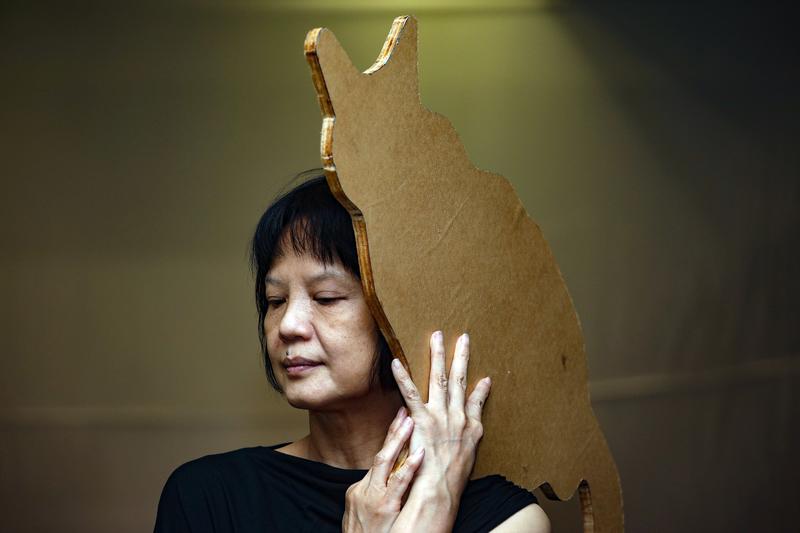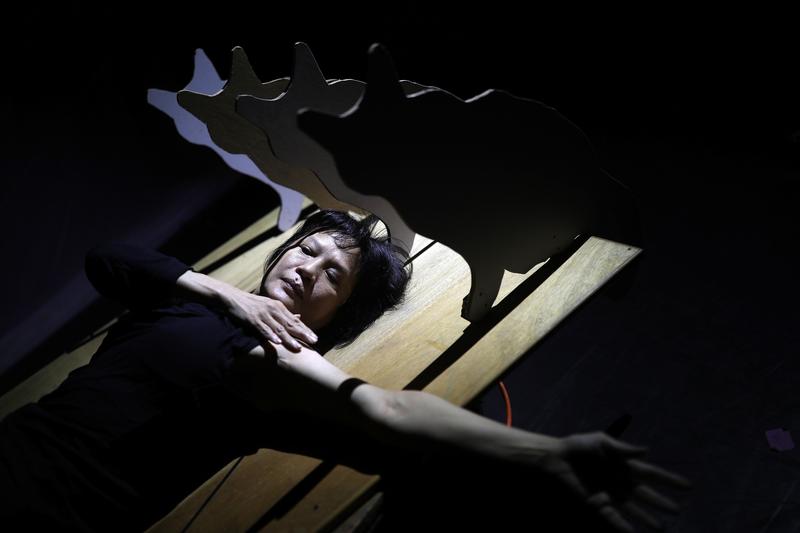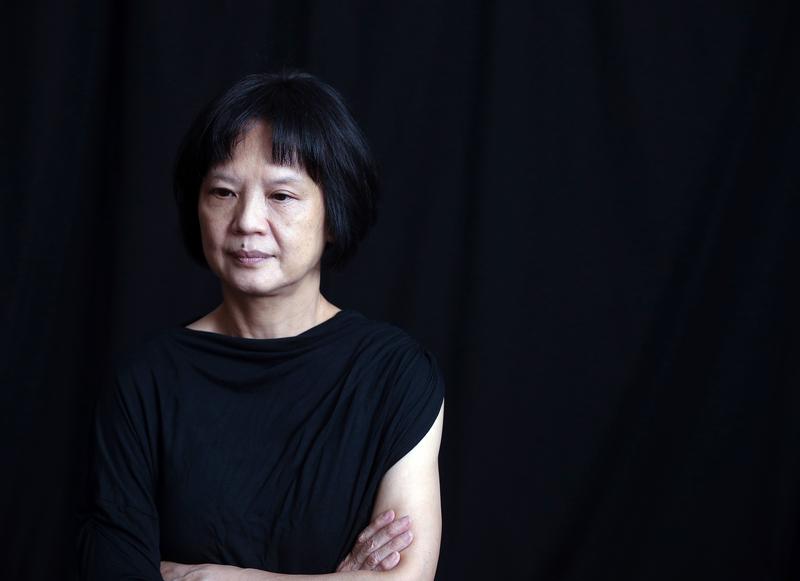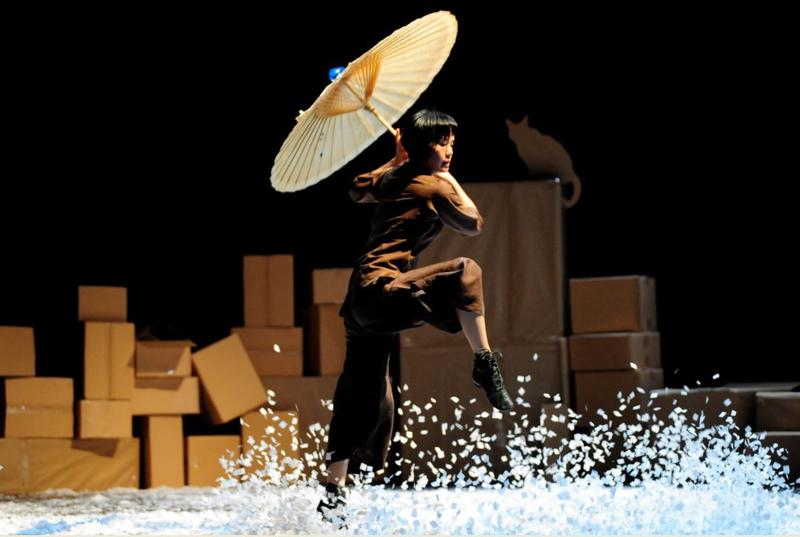Editor’s Note: A leading figure among Hong Kong’s exponents of contemporary dance, Mui Cheuk-yin has been delivering stellar performances since the 1980s but remains as far as possible from having starry airs. When she is not dancing Mui has been rescuing and mothering homeless cats—a chapter of her life that inspired her most-recent dance composition, Diary VII: The Story Of… staged recently in Tai Kwun. Excerpts from an exclusive interview Mui gave recently to China Daily:
 In her most-recent dance piece, Diary VII: The Story Of…, staged recently at Tai Kwun, Mui Cheuk-yin explores the layered dynamic she shares with the cats she has rescued from Hong Kong’s streets. (CALVIN NG / CHINA DAILY)
In her most-recent dance piece, Diary VII: The Story Of…, staged recently at Tai Kwun, Mui Cheuk-yin explores the layered dynamic she shares with the cats she has rescued from Hong Kong’s streets. (CALVIN NG / CHINA DAILY)
The first edition of the Diary series was staged in 1986…
… and that was right here in this studio space (of City Contemporary Dance Company in Wong Tai Sin where the interview was conducted).
That certainly adds an extra layer of poignancy to this interview. What would you say is the most significant change between then and Diary VII: The Story Of…, which was premiered in Tai Kwun recently?
The format has not changed at all. Right from the first version I wanted a mix of theater, dance and (the idea of) writing in the Diary series and that has remained a constant. What was different this time round is that I started working with the lighting designer (Lee Chi-wai) right from the beginning. For example, he would show me some of the light sources he was considering and I would start looking at the possibilities of using them in the piece.
Has the artistic philosophy informing the series changed at all over the years?
When I composed the first piece, I was making it for myself. I kind of envied writers and filmmakers because there are records of their works, while a dance piece disappears as soon as it is performed. So my motivation was quite simple. I wanted to explore if dance could be a vehicle for keeping a record of some of my most cherished memories. I didn’t even have a particular aesthetic in mind. And that has been the same for every edition of Diary, until now.
There seems to be an inherent contradiction here. You are trying to make a performance form that is ephemeral by nature a vehicle of recording and presenting memories in order to make them last beyond the present moment. I think this tension between the permanent and transitory is explored beautifully in the Diary series…
Diary I is a record of my childhood spent in Guangzhou during the Cultural Revolution (1966—76). I was only six years old when it began. Later, when I thought of recording my experiences of that time, as a twenty-something woman, it all seemed unreal. I wanted to create that dance piece because I wanted to re-visit that period of my life.
So to answer your question about the tension between permanence and impermanence, if you re-create something from history (in art), it is alive at that moment.
 The use of shadow puppetry, designed by Lee Chi-wai and Mui herself, makes Diary VII: The Story Of… a hauntingly evocative journey through the dancer’s life story. (CALVIN NG / CHINA DAILY)
The use of shadow puppetry, designed by Lee Chi-wai and Mui herself, makes Diary VII: The Story Of… a hauntingly evocative journey through the dancer’s life story. (CALVIN NG / CHINA DAILY)
Diary VII: The Story Of… emerged out of your concern for homeless cats on the streets of Hong Kong. Would you like to give us a bit of background on this?
One day, many years ago, I was passing through Central. It was raining heavily. I noticed a cat trying to crawl up a cardboard box and not succeeding. I had no idea how to care for cats, but I picked it up anyway and wrapped my coat — it was winter — around it. That was my first cat.
Since then I started noticing cats in distress. I kept four from the first generation of cats I rescued. As for the others, if they were healthy, and cute, I would put an ad in a local newspaper — this was a time before the internet — saying: “Kitten looking for home.” And that’s how some of them were adopted. And those people still call me to let me know how their pets are doing. I made a lot of friends in the process. And all my friends got a cat or two from me anyway.
I have four cats now. Somehow it’s always been four at a time.
Among the first generation cats I rescued, one was blind and another in very bad shape, and a third had behavioral problems. It would always urinate on my bed. But then they are capable of changing if you love them enough, and this one did.
So you have a sustained relationship with cats since a very long time. Is there a reason why you chose to tell this story now through Diary VII?
I feel in my journey through life with the cats they are like my teachers. For example, there is this other one I also found in Central. She was very dirty and covered with sores. I took her to the vet who suggested it might be better to put her to sleep. And then the cat tapped me on the face. So we decided otherwise. Then, after several months of treatment, she emerged quite strong. She had lost one eye but she’s very clever and can easily find her way around in the house. While playing with her I sometimes try to apply the contact improvisation technique that we use in dance, which is to communicate with fellow dancers through body contact, without using language. She simply loves playing that game.
She’s an inspiration for Diary VII then. What’s her name?
Her name’s Maan Chu (blind pig). She seems very happy with her life, despite the disability. Because she cannot see, she has an acute sense of the physicality of things. She will touch my face and try to sniff me. My other cats are (relatively) shy.
Maan Chu has taught me that one may not be perfect and yet perfectly happy. It’s almost like she has reached a state of Zen.
 Mui Cheuk-yin is a leading exponent of contemporary dance who has performed at the prestigious Tanztheatre Wuppertal, a festival that used to be run by the legendary dancer Pina Bausch. (CALVIN NG / CHINA DAILY)
Mui Cheuk-yin is a leading exponent of contemporary dance who has performed at the prestigious Tanztheatre Wuppertal, a festival that used to be run by the legendary dancer Pina Bausch. (CALVIN NG / CHINA DAILY)
In Diary VII you seem to be interested in the layered and shifting dynamic you share with your pets. This is shown through shadow puppetry by manipulating the size of the cat-shaped projections on the screen in relation to the dancer’s figure…
We had many discussions about how to represent cats on stage. We had considered using a giant stuffed toy cat, but I wanted something that would look less real. Eventually we came up with the idea of using shadow puppets mounted on a revolving stage.
By changing the positioning of lights it was possible to change the size of the projected image. It’s like being in a fairytale with a very big cat and you could lie down with your head resting against its belly. I often do that at home and the cats don’t seem to mind. I wanted to create scenes in which I look very small next to a giant shadow of the cat. It feels like going back to my childhood.
Would you like to tell us a bit more about the roles played by lighting designer Lee Chi-wai and set designer Yuen Hon-wai and the nature of your collaboration with them?
Lee and I worked together from the very first day. I shared my ideas with him and then both of us began bringing objects to the studio. I got some cardboard boxes and tried playing with them like cats do. We had great fun. I even brought Maan Chu on the set and played with her a bit.
Eventually we decided to have the shadow puppet projections on this loosely hung white cloth in the background. Because the cloth is not fixed to a surface, it has a fluid texture to it and sometimes helps create a painting-like effect. Also we have played around with the idea of creating the impression of a keyhole on the screen, by placing a cat-shaped puppet next to a reverse cutout of the same and trying to make their shadows fit into one another.
It was interesting to watch this process evolve over the rehearsals. In the beginning we only had some ideas and a few props and the final look of the production emerged over time as we worked out how to put all of those things together.
You have said on earlier occasions that dance movements are to you what words are to writers. By that analogy the Diary series is like a serial autobiography that you are inviting audiences to explore like an open book. Does this make you feel vulnerable sometimes?
It’s fine by me. We dancers expose ourselves to audiences anyway when we perform.
But here you are mining your personal life to use as material for your art…
Regardless of whether it’s about my personal life, as a dancer I am always trying to communicate my true feelings, and in that respect I have never had any problems.
 In a previous edition of Mui’s Diary series, titled Diary VI: Applause, Mui confronted the themes of decay and ageing. (PHOTO COURTESY: TAI KWUN CENTRE FOR HERITAGE & ARTS)
In a previous edition of Mui’s Diary series, titled Diary VI: Applause, Mui confronted the themes of decay and ageing. (PHOTO COURTESY: TAI KWUN CENTRE FOR HERITAGE & ARTS)
Talking of using dance movements like they were words, many of your previous works as a choreographer explore the interface between literature and dance. For instance, you have collaborated with the doyenne of Hong Kong literature, Leung Ping-Kwan (Yasi) and last year you adapted a short story by Pai Hsien-yung into a dance production called The Last Dance. Is there a reason why you are drawn to literature and your works are so imbued with a sense of story-telling?
I think all dance compositions are, at the end of the day, about story-telling, whether it has a narrative or is abstract. It starts from a thing — maybe a color, or a book — and connects with something else, and it is this connection that fascinates me. So as a dancer-choreographer I am connected to the history of my own life and that of the other people I am working with and also that of the audience.
Sometimes when I read a story by a skilled writer, I am struck by how they manage to show me a whole world through words. So I like to choreograph pieces based on other people’s writings, as that way I get to initiate a dialogue with them. Similarly, I can also have a conversation with an object, like in one of my previous works, called Eulogy, I had a section based on my interactions with an umbrella.
Unfortunately, The Last Dance had to be put on hold, after being scheduled and rescheduled a few times because of the erratic rise of COVID-19 cases in Hong Kong in 2020 which caused cultural venues to shut down several times at short notice. What would you say was your biggest takeaway from this experience?
Hong Kong Dance Company will probably stage the production next year.
Regarding lessons from Covid, I think uncertainty is the most normal thing, especially in a dancer’s life. Now because of Covid we are facing a period of uncertainty that’s longer than usual. It’s like when you are stuck at traffic lights and the signal takes longer to change.
I think Covid pushed us into taking this longer-than-usual pause during which we had time to think more and read more before resuming the normal pace of life. It also made us question the idea of “normal”.
Apart from The Last Dance, what kept you busy during the months when people were encouraged to stay at home and avoid physical contact, which is crucial to dancers? How did you cope?
I think it opened up possibilities of spending more time with oneself. I spent the time reading, learnt to cook a few dishes and also about new dance works by watching YouTube videos. Also I had the time to notice the beauty in some the most ordinary things around me.
So I think there was a positive side to not being able to socialize.
Were there any efforts on the part of the leading figures of Hong Kong dance, such as yourself, to support the local community of dancers during the time when many of them did not have any work?
There was some support for performance artists from the Hong Kong Arts Development Council (HKADC) although that was hardly enough. We don’t have a system of ensuring pay protection for performance artists in Hong Kong.
You are a council member of the HKADC. What are your views on the nature of public funding of the arts in the city at present?
In the long term I think we should have enough opportunities for Hong Kong dancers to travel and get more chances to perform abroad. Talented dancer-choreographers should get a chance to show their works to a wider audience. Ideally dancers should grow organically, i.e. you get support to stage the first few shows and on the strength of those performances you can build a portfolio of works that are able to generate income.
Would you still like to play an administrative role in the development of Hong Kong’s dance sector? Or would you say this is a cause best served in your role as an artist and educator?
Yes, if I have a chance I would like to have a role in managing arts funding. As the chair of the Dance Group in HKADC in the past six years, I, along with members of the Dance Committee, would select works by Hong Kong performers to be sent to the Performing Arts Market (in Seoul). This is one way of exploring opportunities.
Hong Kong being such a small place, there is little scope for artists to reach new audiences unless they travel abroad. Of course, there is also the aspect of reaching out to those sections of the local population that do not normally go to watch performances.
Supporting the arts may not always be priority for the government. They might want to put that money in health or welfare funds.
You have associated with the legendary German dancer-choreographer Pina Bausch and performed at Bausch’s Tanztheatre Wuppertal. What is your most cherished memory of her?
I remember her extraordinary strength (of mind). I performed a (self-choreographed) piece called lot.us at her Tanztheater Wuppertal in 2008, only around half a year before she passed away. At that time by looking at her no one could tell how ill she was. She was still working incredibly hard to run her festival, networking with people. I wonder how she dealt with the knowledge that the end was near with such calmness.
I think that’s a great attitude to have, whether or not one is suffering from a serious illness — the idea that one should try to live every minute of one’s life to the fullest while one is alive.
I think a similar idea informs your Diary series… that being alive, in and of itself, is worth a celebration…
Yes I do think the Diary series has that kind of energy. I am very grateful to Tai Kwun for giving a mature artist like me a chance to show her work.
Has it gotten easier or tougher for upcoming Hong Kong dancers to have a career and produce new work since the time you began your journey as a dancer, a fresh dance school graduate perhaps…
I did not go to a dance school before I started out… I enrolled at the Hong Kong Academy of Performing Arts only after I was 40, as I had promised my mum that I would get an academic qualification, because she allowed me to make dancing my career when I was 20.
So in those early years of your career you were self-taught to a large extent. That’s amazing…
I joined Hong Kong Dance Company in 1981 and learnt on the job.
There are many more platforms for young performers today and also many more sources of support. When I staged my first solo I did not have any funding at all. All my friends pitched in to help me. The producer of Diary VII, Chung Siu-mui, helped me with the technical aspects and costumes. Immediately after I had staged that show, which was a compilation of five solo pieces, I was invited to tour Malaysia. I left my salaried job with Hong Kong Dance Company and went on that tour.
I am sure artists in Hong Kong today have a wider scope for showing their works, and know how to spot the opportunities.
In these uncertain times does Hong Kong still feel the right place for a creative artist to work in? Do you feel it is possible to retain artistic integrity and have creative control on the material you would like to work with here?
As of this moment I feel things are okay. I won’t know about what lies ahead. Now we just go with the flow.
Interviewed by Chitralekha Basu


